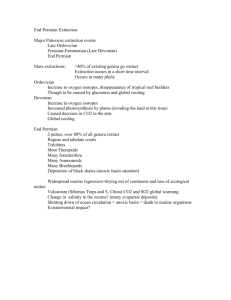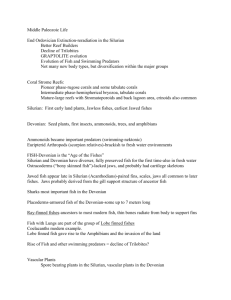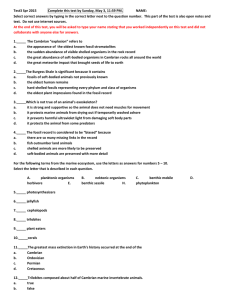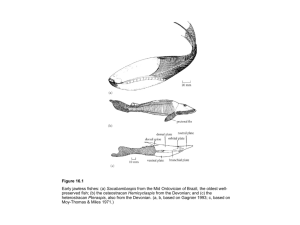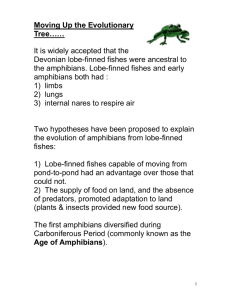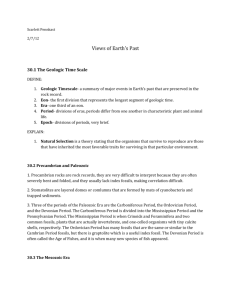Part 2
advertisement
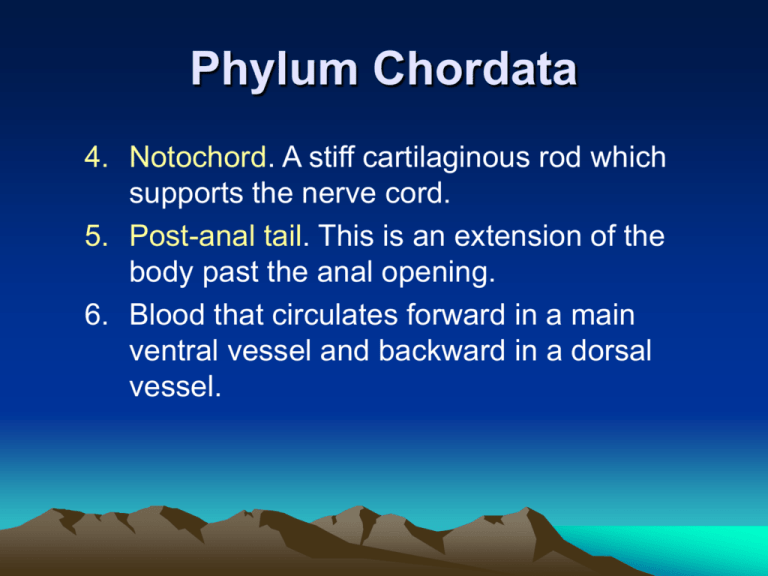
Phylum Chordata 4. Notochord. A stiff cartilaginous rod which supports the nerve cord. 5. Post-anal tail. This is an extension of the body past the anal opening. 6. Blood that circulates forward in a main ventral vessel and backward in a dorsal vessel. Phylum Chordata Subphylum Urochordata • Primitive chordates. Sea squirts, ascidians, or tunicates. Larval forms have notochord in tail region. • Chief characteristics: Adults have sac-like bodies, ranging in size from less than 1 mm to a few cm. Larval form resembles a tadpole and has a notochord, dorsal tubular nerve cord, gill slits, and post-anal tail. Phylum Chordata Subphylum Urochordata • Geologic range: not known • Mode of life: – Inhabit overhangs or shaded areas in the low intertidal and subtidal zone. – Most live attached as adults. – Filter feeders. – Behavior resembles that of a sponge. – Body contracts abruptly expelling water, giving them the name "sea squirts". Phylum Chordata Subphylum Cephalochordata • Primitive chordates. Lancelets, Amphioxus, Branchiostoma. Small marine animals with fishlike bodies and notochord. • Geologic range: Cambrian to Recent. • Mode of life: Bottom dwellers. Lancelets spend much of their time burrowing in the sand in warm, coastal, marine environments. Filter feeders. Relatively sessile but capable of swimming. • Significance: An ancestor to the vertebrates resembled a lancelet-like creature (Pikaia). Chief characteristics: – – – – Lancelets resemble a small, colorless anchovy fillet. No obvious eyes or lateral fins. Worm-like. Has segmented axial muscles, gill slits, a dorsal hollow nerve cord, a notochord, and a post-anal tail. – No solid skeleton. Nothing resembling a vertebral column. What ARE conodonts? • The conodonts were previously placed in a separate phylum (Phylum Conodonta), because their affinities were unknown. • The current interpretation places the conodont-bearing animal with the Chordates in Phylum Chordata. • The organism from which they came is not known with certainty. Examples of various shapes of conodont elements. Images courtesy of Anita Harris, U. S. Geological Survey. Conodonts • Chief characteristics: – Microscopic in size – Composed of calcium fluorapatite. – Shape - cone-shaped teeth, or bars with rows of tooth-like denticles, or irregular knobby plates called platforms. – Each conodont element is part of a larger organism. Most fossil occurrences are of disassociated elements, but occasionally they are found arranged in specific assemblages or “apparatuses”. Conodonts • Name: Conodont means "cone" + "teeth" (dont) • Geologic range: Neoproterozoic to Late Triassic. • Mode of life: Marine, free-swimming. Conodonts • Significance: – Useful in biostratigraphy – Useful in marine paleoenvironmental interpretation – Their color is a good indicator of the temperature to which the rock has been subjected. (This is important in determining whether oil or gas may be present in the rock). Conodonts The color indicates thermal history and burial temperatures. Darker color indicates higher temperature. Temperatures are important to determine whether petroleum may have been generated in the rock, or whether temperatures were too high for petroleum to be preserved. What WAS the conodont animal? • Several fossils of conodont animals have been reported, but most were discredited and reinterpreted as an organism which had actually eaten the conodont animal, because the conodont elements were only in the stomach or digestive tract. What WAS the conodont animal? • Sketch of a conodont animal published in 1993 from the Lower Carboniferous of Scotland. • The conodont animal is found as softbodied impressions. The animals lack skeletal parts except for the conodonts, which occur in the mouth region. What WAS the conodont animal? • A fossil discovered in 1995 in the Ordovician Soom Shale of South Africa contains soft bodied remains of an animal with an elongated eel-like body. • The animal had an eye, and had V-shaped musculature along the sides of the body, as in the amphioxus or lancelet. • The organism has a longitudinal band which may mark the position of the notochord. What were the conodont elements used for in the conodont animal? • Internal laminated structures within conodont elements indicate that new lamellae were added on the outer surface of many elements, suggesting that they were an internal skeletal appatatus, covered with tissue, rather than being used as teeth. • They may have been supports for a foodgathering apparatus. • Some conodonts show evidence of having been broken and subsequently repaired. • The function of the conodont apparatus is not known. Phylum Chordata Subphylum Vertebrata The vertebrates are animals with: • Segmented backbone consisting of vertebrae • Definite head with a skull that encloses a brain • Ventrally-located heart • Well-developed sense organs • Notochord is supplemented or replaced by cartilaginous or bony vertebrae. • Arches of the vertebrae encircle and protect a hollow spinal cord. Phylum Chordata Subphylum Vertebrata • Mode of Life: – Includes both water-dwelling and landdwelling tetrapods (from the Latin, meaning four feet). – Some walk on four legs and some walk only on the hind legs (bipedal). – In some, forelimbs are modified into wings. – In some, the limbs have been modified into flippers. • Geologic range: Cambrian to Recent. Phylum Chordata Subphylum Vertebrata Two major groups of vertebrates: • Non-amniotic vertebrates - Egg lacks a covering and must be fertilized externally. Must be wet or in water to reproduce. – Fish – Amphibians • Amniotic vertebrates - Amniotes. Internal fertilization and an amniotic egg (enclosed egg). Water is not required for reproduction. – Reptiles – Birds – Mammals Amniotic Egg Amnion (or amniotic membrane) encloses the embryo in water (amniotic fluid). Allantois is a reservoir for waste and provides for gas diffusion. It becomes the urinary bladder in the adult. Chorion provides a protective membrane around the egg. Yolk is a storage area for fats, proteins, and other nutrients food for the embryo. Significance of the Amniotic Egg • Provided freedom from dependency on water bodies. • Helped the vertebrates live in diverse types of terrestrial environments. • An important milestone in the evolution of vertebrates. The Fishes There are five classes of fishes. 1. Agnathids or jawless fish 2. Acanthodians or spiny fish with jaws. Extinct. 3. Placoderms or plate skinned fish with jaws. Extinct. 4. Chondrichthyes or fish with cartilaginous skeletons, including sharks, rays, and skates. 5. Osteichthyes or bony fishes. Most modern fish. Led to evolution of tetrapods. Geologic ranges of the five classes of fishes The Oldest Fish • The oldest known fish is from the Cambrian of China (about 535 m.y. old), found in the Chengjiang fossil site in Yunnan Province, Class Agnatha • Jawless fishes, including the living lampreys and hagfishes as well as extinct ostracoderms • Name: "A-" means "without", and "gnatha" means "jaws". • Chief characteristics: Fish without jaws. • Mode of life: Swimmers. Class Agnatha • Geologic range: Cambrian to Recent. Ostracoderms were Ordovician to Devonian. • Jawless fishes are present in the Harding Sandstone (Lower Ordovician) of Colorado. Also found in Lower Ordovician rocks in Australia and Bolivia. Includes Astraspis. Astraspis, an Ordovician jawless fish Ostracoderms • A group of armored jawless fishes called the ostracoderms (name means "shell skin") lived in the Early Paleozoic. • Ostracoderms were mainly small, sluggish fish that were filter feeders or "mud strainers". Ostracoderms • The armor was made of bony material, and served as protection from predators or for storing seasonally available phosphorous. • Bone is made of apatite, which contains phosphorous. Evolution of Jaws • The first fish with jaws appeared in nonmarine rocks in the Late Silurian. • The evolution of the jaw expanded the adaptive range of vertebrates. • Used for biting and grasping. • Led to more varied and active ways of life, and to new sources of food. Evolution of Jaws • Origin of jaws - two hypotheses: – Modification of a front pair of bone or cartilage gill supports. – More recent hypothesis: Modification of the velum, a structure used in respiration and feeding in lamprey larvae. • Both hypotheses are based on anatomy and embryology of living fishes. Class Acanthodii • • • • Acanthodians or spiny fishes. The first fishes to have jaws. Name: "Acanthos" means "spiny". Chief characteristics: Primitive spiny fishes with jaws. • Geologic range: Late Silurian to Permian. Most numerous during the Devonian. Extinct. • Mode of life: Swimmers. Nonmarine. Class Placodermi Dunkleosteus • Placoderms or "plate-skinned" fishes. • Name: "Placo-" means plate and "derm" means "skin". • Chief characteristics: Fish with jaws and armor plating. • Geologic range: Late Silurian to Late Devonian. Extinct. • Mode of life: Swimmers. Some were large carnivorous predators, such as Dunkleosteus, which grew to about 9 m long Class Chondrichthyes - Sharks • Sharks, rays, and skates • Name: From "chondros", meaning "cartilage", and "icthyes" meaning "fish". • Chief characteristics: Cartilaginous fishes. Skeleton made of cartilage not bone. Rarely preserved. • Geologic range: Middle Paleozoic (Late Silurian or Devonian) to Recent. • Mode of life: Swimmers. Marine, except one Late Carboniferous freshwater genus. • The genus Cladoselache, is found in Devonian shales on the southern shore of Lake Erie. Class Osteichthyes - Bony Fishes • Bony fishes • Name: "Osteo" means "bone" and "ichthyes" means "fish". • Chief characteristics: Skeleton of bone, not cartilage. Modern bony fishes are of this type. • Geologic range: Devonian to Recent. • Mode of life: Swimmers. Marine and freshwater. The earliest lived in freshwater. • The most numerous, varied, and successful of all aquatic vertebrates. Class Osteichthyes - Bony Fishes • Bony fishes played a key role in the evolution of tetrapods (four-legged animals). • Two types of bony fish are significant: – Subclass Actinopterygii - the ray-finned fish. – Subclass Sarcopterygii - the lobe-finned fish or lungfish. Subclass Actinopterygii • • • • Ray-finned fish Dominant fishes in the world today. No muscular base to the paired fins. Fins are thin structures supported by radiating rods or rays. • First appeared in Devonian freshwater lakes and streams, and then expanded their geographic range to the sea. Subclass Sarcopterygii - Lobe-finned fish or Lungfish Chief Characteristics: • Leg-like fins: Muscular fins used to "walk" on pond or stream bottoms. • Lungs: A pair of openings in the roof of the mouth led to nostrils. Able to rise to the surface and breathe air with lungs when the water became foul or stagnant. Some had both lungs and gills. Subclass Sarcopterygii – Lobe-finned fish or Lungfish • Geologic range: Late Devonian to Recent • Significance: This group gave rise to the amphibians and other tetrapods (fourlegged animals). • Types of sarcopterygians: – Order Dipnoi or dipnoans – Order Crossopterygii or crossopterygians – the ancestor of the amphibians Order Dipnoi - dipnoans • Chief characteristics: They can breathe with lungs during the dry season, and can burrow into the mud during droughts. • Name: Dipnoi means "double breather" • Significance: This group did not lead to tetrapods, but includes interesting freshwater lungfish living today in Australia, Africa and South America. Devonian lungfish, Dipterus Order Crossopterygii crossopterygians • Chief characteristics: – Short, muscular, paired fins. – Had a single limb bone called the humerus, followed by the radius and ulna in front fins, and the tibia and fibula in hind fins. • The adaptation assisted movement in shallow water, and allowed the fish to move from a stagnant or drying body of water, to another body of water. Order Crossopterygii crossopterygians • Significance: Considered to be ancestral to the amphibians because of the arrangement of bones in their fins, the pattern of bones of the skull, and the structure of their teeth. Late Devonian crossopterygian lungfish, Eusthenopteron. Types of crossopterygian fish 1. Rhipidistians - This group led to the amphibians 2. Coelacanths - Lobe-finned crossopterygian fish invaded the sea and gave rise to coelacanths. Coelacanths were long-believed to be extinct and are considered to be living fossils. One was caught in 1938 near Madagascar. More have been caught since. Latimeria, a modern coelacanth. Tail is similar to that of Eusthenopteron, but very different from that of rayfinned fish. Similarities between Crossopterygian Fish and Amphibians 1. The same limb bones are present. Early amphibian (left). Crossopterygian fish (right). The major limb bones are coded r, u and h. r = radius u = ulna h = humurus Similarities between Crossopterygian Fish and Amphibians 2. The same skull bones are present. Crossopterygian fish (left) and the Devonian amphibian, Ichthyostega (right). The Advent of Tetrapods • Tens of millions of generations passed before crossopterygian fish evolved into animals that could live entirely on land. The early tetrapods (four-legged animals) continued to return to water to lay their fish-like, naked eggs. Fish-like tadpoles hatched from these eggs, which used gills for respiration. Anatomical changes associated with the shift from water to land: 1. Three-chambered heart developed and functioned to pump blood more efficiently to the lungs 2. Limb and girdle bones altered to support the body above the ground 3. Spinal column changed to become sturdy but flexible 4. Fish spiracle (vestigial gill slit) became amphibian eustachian tube and middle ear Anatomical changes associated with the shift from water to land: 5. Bones of the ear changed to function better in air than in water (modification of hyomandibular bone that propped fish braincase and upper jaw together, into an ear ossicle called the stapes) 6. Eardrum (tympanic membrane) formed across a notch in the skull Amphibians are interpreted to be descended from crossopterygian fishes because of: 1. Arrangement of bones in amphibian limbs compared with the fins of crossopterygian fish 2. Pattern of bones of the skull 3. Structure of the teeth - highly infolded like a maze (or labyrinth), and called labyrinthodont teeth. 4. Bones of the spinal column in early forms. Class Amphibia – The Amphibians • Name: "Amphi" means "both" or "double", and "bios" means "life". "Amphibios" means living a double life, referring to living in water and on the land. • Chief characteristics and mode of life: Amphibians can live on the land as adults, but they lay their eggs in water. Young amphibians live in the water and are fishlike (tadpoles). The Amphibians • Geologic range: Late Devonian to Recent. • For 50 million years, from the Late Devonian to the Middle Carboniferous, amphibians were the only vertebrates to the inhabit the land. Some adult amphibians reverted to an aquatic mode of life, while others retained a terrestrial lifestyle. Ichthyostega – The First Amphibian • The first terrestrial vertebrate, Ichthyostega, appeared in the Late Devonian, about 375 m.y. ago • Found in freshwater deposits. • "Ichthyo" means "fish" and "stega" means "roof" or "cover" (probably referring to the bones in the roof of the skull). Ichthyostega – The First Amphibian • Ichthyostega retained many features of its fish ancestors, such as: – Scales – Similar skull structure, including arrangement of nostrils – Loosely connected fish-like spinal column • It also had a number of unique traits such as: – Five-toed limbs – Pelvic and pectoral girdles, allowing it to walk on land • Amphibians inhabited the Carboniferous coal swamps, and were abundant and varied. • They had several different modes of life, including some with an aquatic lifestyle (as suggested by features such as a flattened body and skull, reduced limbs, and a slender snake-like body), and some that were clearly land dwellers (with stout limbs, short body and tail). Skull of Neopteroplax, 290 m.y. ago, aquatic amphibian from the Late Carboniferous of Ohio. Features suggesting an aquatic lifestyle include a flattened body and skull, reduced limbs, and a slender snake-like body. • Some Carboniferous amphibians were quite large, ranging up to 20 feet (about 6-7 m) long. In contrast, most living amphibians are small. • Eryops, large amphibian (about 5 ft or nearly 2 m long) from the Permian. • Eryops had short, powerful limbs, which suggest that it was primarily a land dweller. • Some Permian amphibians, such as Seymouria, exhibit a combination of amphibian and reptilian features. • Seymouria, a land-dwelling amphibian from the Lower Permian of Texas, 260 m.y. ago, was less than 3 ft long. • Note stout limbs, short body and tail. • A primitive amphibian similar to Seymouria was probably ancestral to the reptiles. Two major groups of vertebrates: • Non-amniotic vertebrates - Egg lacks a covering and must be fertilized externally. Must be wet or in water to reproduce. – Fish – Amphibians • Amniotic vertebrates - Amniotes. Internal fertilization and an amniotic egg (enclosed egg). Water is not required for reproduction. – Reptiles – Birds – Mammals Characteristics of the Amniotic Egg • Durable outer shell protects embryo from drying • Egg can be laid on land • Yolky part of egg provides nutrition; sac contains embryo and another sac collects waste products. • Eliminated need to lay eggs in water, allowing vertebrates to live and reproduce on dry land for the first time. • Amniotic egg probably evolved in Carboniferous. • First fossil eggs are Early Permian Amniotic Egg Amnion (or amniotic membrane) encloses the embryo in water (amniotic fluid). Allantois is a reservoir for waste and provides for gas diffusion. It becomes the urinary bladder in the adult. Chorion provides a protective membrane around the egg. Yolk is a storage area for fats, proteins, and other nutrients food for the embryo. Significance of the Amniotic Egg • Provided freedom from dependency on water bodies. • Helped the vertebrates live in diverse types of terrestrial environments. • An important milestone in the evolution of vertebrates. Class Reptilia - The Reptiles • Name: From "reptilis" meaning "creeping". • Chief characteristics: Skull characteristics that distinguish reptiles from amphibians: – Reptile skull is high and narrow, compared with the low, broad amphibian skull. – In reptiles, the roof of the mouth is arched, with small openings. In amphibians, it is flat with large openings. Class Reptilia - The Reptiles • Mode of life: Complete colonization of land was achieved by the reptiles, which can lay their eggs on dry land. • Geologic range: Pennsylvanian to Recent. • The oldest reptile fossils, genus Hylonomus, (300 m.y. old) are found in Nova Scotia inside fossilized hollow trees filled with sediment. These reptiles were about 24 cm (1 ft) long. They resemble modern insect-eating lizards. Vertebrate Skulls Vertebrates can be distinguished on the position and number of skull openings behind the eye. – Anapsida (no holes) - amphibians, the earliest known reptile (Hylonomus), and turtles – Diapsida (two holes) - dinosaurs, flying reptiles, birds, and living reptiles except turtles – Euryapsida (upper hole only) - extinct marine reptiles – Synapsida (lower hole only) pelycosaurs, therapsids, and mammals Diagram showing the evolution of reptiles and synapsids. Class Synapsida The Synapsids • The synapsids had diverged from the reptiles by the Late Carboniferous. • The synapsids were long considered to be a subclass of reptile, but more recent cladistic analysis shows that they diverged from ancestors completely different than Hylonomus and other true reptiles. The Synapsids • The synapsids were the dominant terrestrial vertebrate in the Permian. • This group was formerly called the "mammal-like reptiles", however the name has been abandoned because they are not really reptiles. • Synapsids include the pelycosaurs and the therapsids. Pelycosaurs • Several species of pelycosaurs had fins or "sails" on their backs, supported by rod-like extensions of their vertebrae. These sails may have been used as temperature regulating mechanisms. • Pelycosaurs lived in the Carboniferous and Permian. Sail-backed forms are Permian. The Permian pelycosaur, Edaphosaurus. Pelycosaurs • Two well known pelycosaurs, which evolved their sails independently were the carnivorous Dimetrodon, and the planteating Edaphosaurus. • Dimetrodon has a larger skull and teeth than does Edaphosaurus, suggesting that Dimetrodon was a meat-eater. Therapsids Therapsids were small to moderate-sized animals with mammalian skeletal characteristics: 1. Fewer bones in the skull than the other reptiles 2. Mammal-like structure of the jaw 3. Differentiated teeth (incisors, canines, and cheek teeth) 4. Limbs in more direct alignment beneath the body 5. Reduction of ribs in the neck and lumbar regions, allowing greater flexibility Therapsids 6. Double ball-and-socket joint between the skull and neck 7. Bony palate which permitted breathing while chewing (an important characteristic for animals evolving toward mammalian warmbloodedness). Efficient breathing provides oxygen needed to derive heat energy from food. 8. Whisker pits on the snout. Geologic range: Permian to Triassic. Therapsids - Cynognathus • Mammal-like features are well developed in the therapsid, Cynognathus. • Name: From "kynos" meaning "dog" and "gnathos" meaning "jaw" or "tooth". Cynognathus crateronotus, a therapsid from the Early Triassic (230-225 m.y.), Cape Province, South Africa. Note the differentiated teeth. This animal was a predator. Therapsids - Cynognathus • Examination of the bone on the snout portion of the skull reveals probable "whisker pits", suggesting that they had hair, which may have functioned to insulate the animal and slow the rate of heat loss. Cynognathus crateronotus, a therapsid from the Early Triassic (230-225 m.y.), Cape Province, South Africa. Note the differentiated teeth. This animal was a predator. Plants of the Paleozoic Stromatolites - A Photosynthetic Plant Ancestor • The earliest photosynthetic organisms were in the sea. • Stromatolites, built by photosynthetic bacteria (cyanobacteria, sometimes called blue-green algae), were ancestral to the Paleozoic plants. They were not plants themselves. • Kingdom Eubacteria. Stromatolites growing in the intertidal zone of Shark Bay, western Australia Stromatolites - A Photosynthetic Plant Ancestor • Stromatolites: – Appeared in the Archean – Expanded during the Proterozoic – Are present in limestones of the Phanerozoic. • Most Precambrian stromatolites grew in shallow marine and intertidal environments, but some lived in freshwater. Stromatolites - A Photosynthetic Plant Ancestor • Stromatolite reefs were widespread during the Cambrian, but declined in the Ordovician. They are typically found in areas lacking marine invertebrates, which feed on the cyanobacterial mats. • The appearance of abundant marine invertebrates in the Cambrian led to the decline of the stromatolites. Why? They ate them. Marine Algae • • • The next step in the evolutionary path to land plants was probably the green algae or chlorophytes. Kingdom Protista. Marine algae fossils are found in some Paleozoic rocks. Types of marine algae: 1. Chlorophytes 2. Receptaculitids Chlorophytes 1. Chlorophytes - Green algae. • Cambrian to Recent. • A close relationship between chlorophytes and land plants is suggested by the adaptation of some species to freshwater and moist soil. Receptaculitids 2. Receptaculitids are lower Paleozoic marine fossils resembling sunflowers. – Produced by organisms of uncertain affinity. – Interpreted as lime-secreting algae. – Most are found in the Ordovician, but they are also present in the Silurian and Devonian. Land Plants Land plants include: 1. Bryophytes - non-vascular plants Mosses, liverworts, and hornworts. Devonian to Recent. 2. Tracheophytes - vascular plants Trees, ferns, and flowering plants. Silurian to Recent Tracheophytes • Tracheophytes have vascular tissues, or an internal system of tubes and vessels, that transport water and nutrients from one part of the plant to another. • A water transport system is important, because plants generally withdraw water from below the ground. Below the ground there is water but no light. Above the ground there is sunlight but there may not be water. The vascular system allows the plant to take advantage of both places. Tracheophytes • The oldest unquestioned vascular plant fossils occur in Silurian rocks. • Small, leafless plants with thin branching stems. • These plants are called psilophytes. • Spore bodies are present on the ends of the stems in fossils of Cooksonia. Cooksonia, an early vascular plant in the Late Silurian - Early Devonian. Height about 4 cm. Major Advances in Land Plants Three major advances in land plant history, developing more efficient reproductive systems: 1. Seedless spore-bearing plants, appearing in the Ordovician, and flourishing in Carboniferous coal swamps 2. Seed-producing, pollinating, but non-flowering plants appearing in the Late Devonian (gymnosperms, such as conifers) 3. Flowering plants, appearing in the Late Mesozoic (angiosperms) Spore-bearing Plants • The first plants to invade the land were spore-bearing plants. • In fact, the first evidence of land plants is the presence of spores in Ordovician rocks. • Spores are plant reproductive structures. Familiar spore-bearing plants include mosses and ferns. Life Cycle of Spore-bearing Plants • The life cycle of spore-bearing plants differs from that of the more familiar seedbearing plants. • Alternation of generations between diploid (double set of chromosomes) and haploid (single set of chromosomes) forms. • Water is required for fertilization. The First Seeds • Seeds appeared in the Late Devonian, although it is not known which plant produced them. • Seed-bearing plants became more abundant in the Carboniferous. • The seed is significant because it freed plants from their dependence on moist environments and allowed them to inhabit dry land, much as the amniotic egg freed animals from their dependence on wet environments. Invasion of the Land by Plants The invasion of the land by plants profoundly altered the landscape. – Plant roots slowed erosion. – Decaying vegetation led to soil formation. – Plants also provided a food source for animals, which invaded the land after the appearance of land plants. Animals could not have survived on land without a food source (plants) in place. Evolution of Wood • As plants evolved wood, they were able to withstand the pull of gravity and grow taller. • During the Middle Devonian, the first wood appeared in plants of the genus Rhynia. Rhynia, a middle Devonian vascular land plant with woody tissues called xylem. The First Trees • The first trees were present by the Late Devonian. • By the Carboniferous, trees reached 30 m tall or more, with trunks 1 m in diameter. Carboniferous Coal • There are more plant fossils in Carboniferous strata than in any other geologic interval. • Plants gave the Carboniferous its name, because of the vast coal deposits which formed from plant remains in lowland swamps. Coal is dominated by the element carbon. • Coal represents an enormous biomass of plants because it takes several cubic meters of wood to make one cubic meter of coal. Common plants in the Carboniferous 1. 2. 3. 4. Lycopods or Lycopsids - club mosses Sphenopsids - horsetails, scouring rushes Ferns Gymnosperms a. b. c. d. Seed ferns Cordaites Conifers Ginkgoes Lycopods or Lycopsids • Phylum Lycopodophyta or Lycopsida • Club mosses, scale trees • Spore-bearing plants were confined to swamps because spores require moisture to germinate. • Some grew to be 30 m tall and 1 m diameter. • Geologic range: Silurian to Recent. Few after the Permian. • Common genera = Lepidodendron and Sigillaria. Sphenopsids • Phylum Equisetaphyta or Sphenopsida • Spore-bearing and similar to living horsetails or scouring rushes. • Interpreted as living in moist areas or standing water. • Geologic range: Devonian to Recent. Few after the Permian. • Common genus = Calamites Ferns • Phylum Polypodiophyta • Ferns are vascular plants that reproduce by means of spores. • They live in moist habitats. • Geologic range: Devonian to Recent. Gymnosperms • Phylum Pinophyta or Gymnospermophyta • Conifers, cycads, ginkgoes, and various evergreen plants without flowers • The word "gymnosperm" means "naked seed". • Seed-bearing plants. No flowers. • Seed-bearing plants no longer require moist habitats. This led to the expansion of plants into drier areas. • Geologic range: Middle Paleozoic to Recent. Seed ferns • Gymnosperms. Class Pteridospermophyta • Fernlike leaves, but reproduced with seeds instead of spores. • Geologic range: Devonian to Recent. • Common genera = Neuropteris and Glossopteris. • One of the best-known is Glossopteris, which lived in Gondwana during the Carboniferous and Permian. They were sometimes associated with glacial deposits, suggesting that they were adapted to cool climates. Cordaites • Gymnosperms. Class Pinopsida, Order Cordaitales • Seed-bearing gymnosperms with strap-like leaves that were ancestors to the modern conifers. • Tall trees (up to 50 m). • Abundant in Carboniferous coal swamps. • Extinct by the end of the Permian. Conifers • Gymnosperms. Class Pinopsida, Order Coniferales • The word "conifer" means "cone bearing". • Trees with cones which contain seeds. • Today conifers are represented by trees such as pines, cedars, hemlocks, spruces, firs, etc. • Conifers spread widely during the Permian, perhaps as a result of the drier conditions which led to the demise of the coal swamps. Ginkgoes • • • • • Gymnosperms. Class Ginkgopsida Deciduous trees (they drop their leaves) Fan-shaped leaves. They produce a fleshy fruit but have no flowers. Geologic range: Early Permian to Recent. Maximum diversity in the Jurassic. • Represented by a single species today, Ginkgo biloba. It is extinct in the wild, but is widely grown as an ornamental tree. Mass Extinctions in the Paleozoic • The Paleozoic was a time of adaptive radiations and extinctions. • Many of the geologic periods of the Paleozoic began with adaptive radiations, or times of rapid evolution of organisms. Several of the Paleozoic periods ended with extinction events of varying severity. Mass Extinctions in the Paleozoic The three most catastrophic extinctions in the Paleozoic Era were at the following times: – End of the Ordovician Period (443 m.y. ago) – End of the Devonian Period (359 m.y. ago) – End of the Permian Period (251 m.y. ago) The Permian extinction was the most severe. The extinction at the end of the Permian Period is considered to be the most catastrophic mass extinction in the history of life. Diversity of marine animals, and extinction events over geologic time. Late Ordovician Extinctions • Following a slight dip in diversity at the end of the Cambrian, the Ordovician was a time of renewed diversification. The number of genera increased rapidly, and the number of families increased from about 160 to 530. This increase was particularly dramatic among trilobites, brachiopods, bivalved molluscs, and gastropods. • An extinction event at the end of the Ordovician led to an abrupt decline in diversity. Late Ordovician Extinctions • The extinction occurred in two phases. – First phase - affected planktonic and nektonic (floating and swimming) organisms such as graptolites, acritarchs, many nautiloids and conodonts, as well as benthic (bottomdwelling) organisms such as trilobites, bryozoa, corals, and brachiopods. – Second phase - affected several trilobite groups, corals, conodonts, and bryozoans. Late Ordovician Extinctions • Both phases of the extinction event were related to global cooling and the growth of glaciers in Gondwana. • Glaciation was coupled with the lowering of sea level and a reduction in shallow water habitat. • As the climate cooled, tropical organisms showed the greatest decline. • As warming occurred and the glaciers began to melt, organisms which were adapted to the cooler conditions began to suffer extinction. This was the second phase of extinctions. Late Devonian Extinctions The Late Devonian extinctions occurred over a span of about 20 million years, and appear to have been the result of an ecological crisis in the seas, perhaps induced by changes occurring on the land. Late Devonian Extinctions • The Devonian was the time of the appearance of trees and spread of land plants. This would have accelerated weathering rates, leading to large volumes of nutrients being washed into the seas. • Large quantities of nutrients in the water (such as phosphorus) causes algal blooms. • Bacteria breaking down large quantities of dead algae uses up all of the oxygen in the water, causing anoxic conditions (= "without oxygen"). • This process is called eutrophication, and it occurs today in lakes, and causes massive "fish kills". Late Devonian Extinctions • Extensive Devonian black shale deposits (for example, the Chattanooga Shale) suggest the widespread occurrence of anoxic conditions in the Devonian sea. • Glaciation may have been an additional contributing factor. By the Late Devonian, South America had drifted over the South Pole, and glaciations occurred. • Overall, 70% of marine invertebrate families went extinct in the Late Devonian. Late Devonian Extinctions Organisms most strongly affected (but not totally wiped out) by the Devonian extinction were: – Tabulate corals – Rugose corals – Stromatoporoids – Brachiopods – Goniatite ammonoids (cephalopod molluscs) – Trilobites – Conodonts – Placoderm fish Late Permian Extinctions • The Late Permian is marked by a catastrophic extinction event which resulted in the total disappearance of many animal groups. • This was the largest extinction event in the history of life, exceeding even the extinction event at the end of the Cretaceous, which killed the dinosaurs. Late Permian Extinctions • More than 90% of all marine species that existed in the Permian disappeared or were severely reduced in number. • Nearly half of the known families disappeared. • Tropical forms experienced the most extensive losses. Late Permian Extinctions • The following marine organisms were extinct by the end of the Permian: – Fusulinid foraminifera – Rugose corals – Tabulate corals – Blastoids – Trilobites (which had become extinct somewhat earlier in the Permian) Late Permian Extinctions • Other groups of organisms were severely reduced in diversity, with some surviving species: – Brachiopods – Crinoids – Bryozoa – Ammonoids • Organisms which inhabited warm waters shifted their distributions toward the equator. Cool conditions prevented construction of reefs and the formation of limestones. Late Permian Extinctions • The Permian extinction also affected land dwellers. • More than 70% of land animals disappeared or were severely reduced, including: – Amphibian families – Reptile families – Synapsids (once called "mammal-like reptiles") Late Permian Extinctions • Among the plants, the spore-bearing plants that inhabited tropical coal swamps were replaced by seed-bearing gymnosperms, that could inhabit cooler, drier climatic conditions. Contributing Factors Many factors may have contributed to the Permian mass extinction: 1. Climatic change associated with assembly of Pangea – Global cooling and drying, along with interruption of equatorial circulation 2. Glaciation at both north and south ends of Pangea 3. Reduction in epicontinental seas as sea level dropped (habitat loss) Contributing Factors 4. Unusually active volcanism releasing CO2 (flood basalts in Siberia), leading to global warming, which may have triggered release of large stores of methane gas frozen in sediments on the sea floor, causing increased global warming. 5. Possibility of an extraterrestrial impact, as indicated by spherical carbon molecules containing an extraterrestrial helium-3 isotope
